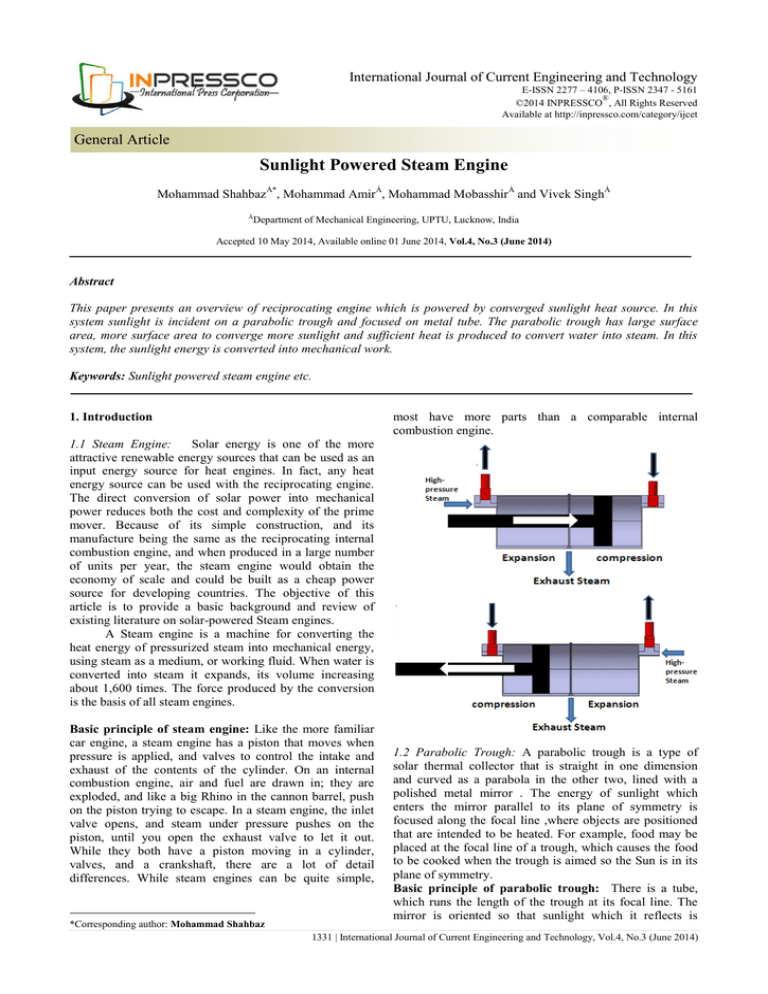
International Journal of Current Engineering and Technology
E-ISSN 2277 – 4106, P-ISSN 2347 - 5161
®
©2014 INPRESSCO , All Rights Reserved
Available at http://inpressco.com/category/ijcet
General Article
Sunlight Powered Steam Engine
Mohammad ShahbazȦ*, Mohammad AmirȦ, Mohammad MobasshirȦ and Vivek SinghȦ
Ȧ
Department of Mechanical Engineering, UPTU, Lucknow, India
Accepted 10 May 2014, Available online 01 June 2014, Vol.4, No.3 (June 2014)
Abstract
This paper presents an overview of reciprocating engine which is powered by converged sunlight heat source. In this
system sunlight is incident on a parabolic trough and focused on metal tube. The parabolic trough has large surface
area, more surface area to converge more sunlight and sufficient heat is produced to convert water into steam. In this
system, the sunlight energy is converted into mechanical work.
Keywords: Sunlight powered steam engine etc.
most have more parts than a comparable internal
combustion engine.
1. Introduction
1
1.1 Steam Engine:
Solar energy is one of the more
attractive renewable energy sources that can be used as an
input energy source for heat engines. In fact, any heat
energy source can be used with the reciprocating engine.
The direct conversion of solar power into mechanical
power reduces both the cost and complexity of the prime
mover. Because of its simple construction, and its
manufacture being the same as the reciprocating internal
combustion engine, and when produced in a large number
of units per year, the steam engine would obtain the
economy of scale and could be built as a cheap power
source for developing countries. The objective of this
article is to provide a basic background and review of
existing literature on solar-powered Steam engines.
A Steam engine is a machine for converting the
heat energy of pressurized steam into mechanical energy,
using steam as a medium, or working fluid. When water is
converted into steam it expands, its volume increasing
about 1,600 times. The force produced by the conversion
is the basis of all steam engines.
Basic principle of steam engine: Like the more familiar
car engine, a steam engine has a piston that moves when
pressure is applied, and valves to control the intake and
exhaust of the contents of the cylinder. On an internal
combustion engine, air and fuel are drawn in; they are
exploded, and like a big Rhino in the cannon barrel, push
on the piston trying to escape. In a steam engine, the inlet
valve opens, and steam under pressure pushes on the
piston, until you open the exhaust valve to let it out.
While they both have a piston moving in a cylinder,
valves, and a crankshaft, there are a lot of detail
differences. While steam engines can be quite simple,
*Corresponding author: Mohammad Shahbaz
1.2 Parabolic Trough: A parabolic trough is a type of
solar thermal collector that is straight in one dimension
and curved as a parabola in the other two, lined with a
polished metal mirror . The energy of sunlight which
enters the mirror parallel to its plane of symmetry is
focused along the focal line ,where objects are positioned
that are intended to be heated. For example, food may be
placed at the focal line of a trough, which causes the food
to be cooked when the trough is aimed so the Sun is in its
plane of symmetry.
Basic principle of parabolic trough: There is a tube,
which runs the length of the trough at its focal line. The
mirror is oriented so that sunlight which it reflects is
1331 | International Journal of Current Engineering and Technology, Vol.4, No.3 (June 2014)
Mohammad Shahbaz et al
Sunlight Powered Steam Engine
concentrated on the tube, which contains a fluid which is
heated to a high temperature by the energy of the sunlight.
The hot fluid can be used for many purposes. Often, it is
piped to a heat engine, which uses the heat energy to drive
machinery or to generate electricity. This solar energy
collector is the most common and best known type of
parabolic trough.
Heat transfer fluid (usually thermal oil ) runs through the
tube to absorb the concentrated sunlight. This increases the
temperature of the fluid to some 400°C. The heat transfer
fluid is then used to heat steam in a standard turbine
generator. The process is economical and, for heating the
pipe, thermal efficiency ranges from 60-80%.
Cloud reflect 17% back into space.If the earth gets
more cloudy.
8% scattered backwards by air molecules.
19% gets absorbed directly by dust,ozone and water
vapour in the upper atmosphere.
4% get absorbed by cloud located in the troposphere.
The remaining 47% of the sunlight that reaches the
surface.
Conclusions
2. Engine drive by steam by using parabolic trough
The system consists of water tank, heat absorbing tube,
reciprocating steam engine and parabolic trough. The
water tank is located over the height of absorbing tube as
shown in figure, the parabolic trough is set as the focus of
sunlight is concentrated on absorbing tube to produce
heat. This heat is utilized to convert water into steam at
high temperature and pressure. The pressure is sufficient
to run the reciprocating engine. Finally engine gives the
mechanical work from the source of sunlight, and it can be
utilized into many purposes like to drive wheel, to produce
electricity from dynamo or generator, to run the
compressor, etc.
The objective of this article is to provide a basic
background and review of existing literature on solarpowered Steam engines and low temperature differential
Steam engine technology.
The Steam engine could be used in many application such
as:
1. a very good cooling source is available;
2. quiet operation is required;
3. relatively low speed operation is permitted;
4. constant power output operation is permitted;
5. slow changing of engine power output is permitted;
6. a long warm-up period is permitted.
In this model there is a best utilization of nonconventional energy resources from Sunlight for
producing a mechanical power and it can be utilized into
many purpose like to drive wheel, to produce electricity
from dynamo or generator, to run the compressor, etc.
References
Sunlight powered steam engine
Energy balance in the atmosphere
Wiser, Wendell H. (2000). Energy resources: occurrence,
production, conversion, use. Birkhäuser. p. 190. ISBN 978-0387-98744-6.
Heron Alexandrinus (Hero of Alexandria) (c. 62 CE): Spiritalia
seu Pneumatica. Reprinted 1998 by K G Saur GmbH, Munich.
ISBN 3-519-01413-0.
Dayton, Fred Erving (1925). Two Thousand Years of Steam.
Steamboat Days. Frederick A. Stokes company. p. 1.
Hero of Alexandria; Bennet Woodcroft (trans.) (1851). Temple
Doors opened by Fire on an Altar. Pneumatics of Hero of
1332 | International Journal of Current Engineering and Technology, Vol.4, No.3 (June 2014)
Mohammad Shahbaz et al
Sunlight Powered Steam Engine
Alexandria. London: Taylor Walton and Maberly (online
edition from University of Rochester, Rochester, NY).
Retrieved 2008-04-23.
Thurston, Robert (1878), A history of the growth of the steam
engine. History.rochester.edu. 1996-12-16. Retrieved 2012-0126.
Thurston, Robert Henry (1996 (reprint)). A History of the Growth
of the Steam-Engine. Elibron. p. page 12. ISBN 1-4021-62057.
Taqi al-Din and the First Steam Turbine, 1551 A.D., web page,
accessed on line October 23, 2009; this web page refers to
Ahmad Y Hassan (1976), Taqi al-Din and Arabic Mechanical
Engineering, pp. 34-5, Institute for the History of Arabic
Science, University of Aleppo.
University of Rochester, NY, ''The growth of the steam engine''
online history resource, chapter one. History.rochester.edu.
Retrieved 2012-01-26.
Robert Henry Thurston, A history of the growth of the steamengine, D. Appleton and company, 1903, Google Print, p.1516 (public domain)
Garcia, Nicolas (2007). Mas alla de la Leyenda Negra. Valencia:
Universidad de Valencia. pp. 443–454. ISBN 9788437067919.
Bergman, Theodore L., et al. Introduction to Heat Transfer. 6th
ed. Hoboken: Wiley, 2011. Print
Duffie, John A., and William A. Beckman. Solar Engineering of
Thermal Processes. 3rd ed.Hoboken: Wiley, 2006. Print.
Eames, P. C., et al. Modelling Line-Axis Solar Concentrators in
the Medium Temperature Range. Renewable Energy 16
(1999): 743-48. Elsevier. Web. 12 Nov. 2012.
Feuermann, Daniel, and Jeffrey M. Gordon. Solar Fiber Optic
Mini Dishes. Solar Energy 65.3 (1999): 159-70. Print.
Powell, Kody M., and Thomas F. Edgar. Modeling and control of
a solar thermal powerplant with thermal energy storage.
Chemical Engineering Science 71 (2011): 138-45. Science
Direct. Web. 12 Nov. 2012.
Sardeshpande, Vishal R., Ajay G. Chandak, and Indu R. Pillai.
Procedure for thermal performance evaluation of steam
generating point-focus solar concentrators. Solar
Energy 85 (2011): 1390-98. Science Direct. Web. 12 Nov. 2012.
Young, Hugh, Roger Freedman, and Lewis Ford. University
Physics. 12th ed. Boston: Addison- Wesley, 2007.
1333 | International Journal of Current Engineering and Technology, Vol.4, No.3 (June 2014)





